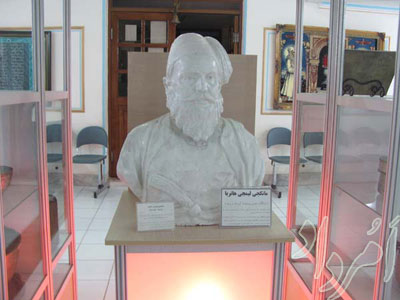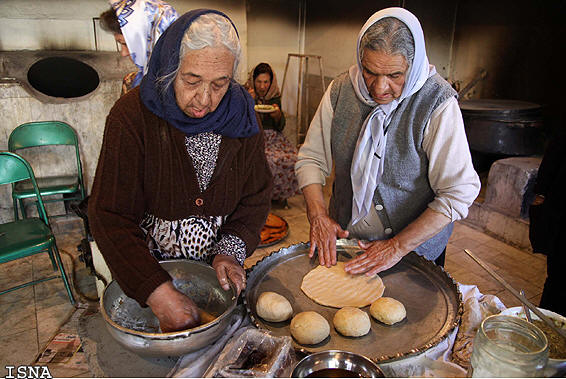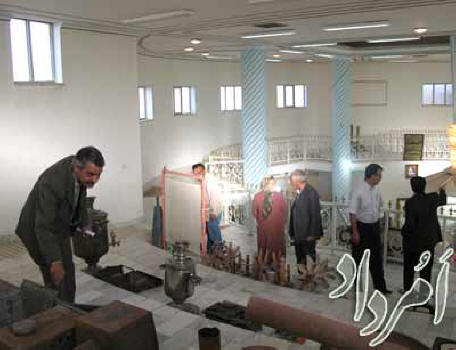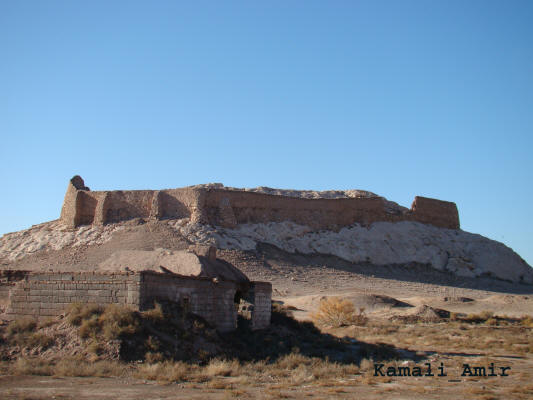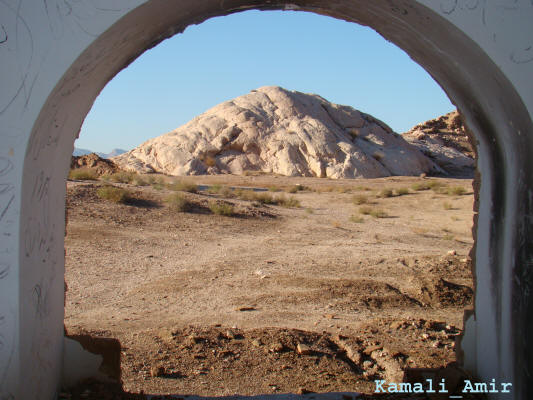Page 2: Zoroastrianism in Kerman

Contents
|
Suggested additional reading:
 |
| Kermani Zoroastrian priests during Jashne Sadeh. Image credit: CAIS |
 |
| Kermani Zoroastrian community welcoming Dr. Jehangir Mahyar Kutvar. Image credit: Oshihan |
Kerman's Zoroastrian Population
Kerman together with Yazd and Pars (Persia) became part of the Zoroastrian group of nations after the close of the Avestan canon, that is, the time when no further additions to the Avesta were made. Kerman could very well have received Zoroastrianism via Khorasan and Siestan rather than via Pars and Yazd. After the Islamic Arab invasion of Iran, Kerman and Yazd became the two provinces that continued to maintain significant numbers of Zoroastrians and therefore Zoroastrian neighbourhoods.
After the Arab invasion of Iran in 650 CE, many Zoroastrians from different parts of Iran sought refuge in the provinces of Yazd and Kerman seeking perhaps some safety in numbers. While many Zoroastrians from Parsa (Pars) and the northwest migrated to Yazd, Zoroastrians from eastern Iran migrated to Kerman. For instance, during Nader Shah's time (1736 -1747 CE), it is estimated that of the Zoroastrians in Kerman, 8,000 were from Khorasan and 2,000 from Siestan. By the time Maneckji Hataria arrived in Iran in the 1850s, he counted only 450 Zoroastrians (perhaps only those secure enough to declare their identity) in Kerman. Fifty years later in 1905, perhaps because of the efforts of Maneckji Hataria, Professor A. V. Jackson placed the Kermani Zoroastrian population at 2,400, and in 1975 their number was estimated at 2,000 by G. Windfuhr. Today, if the numbers of Zoroastrians in Kerman are decreasing, it is because of the steady migration to the capital city Tehran and to other countries.
Kerman City's Zoroastrian Neighbourhood - Gabr-Mahalla / Mahale
 |
Kermani Zoroastrian couple.
Image credit: BBC |
Gabr-Mahalla / Mahale means Zoroastrian-infidel-neighbourhood, a derogatory term placed on Zoroastrians but the Muslims (another derogatory label was atash-parast or fire-worshipper). Kerman city has a Gabr-Mahalla / Mahale. Before the start of the Iranian Zoroastrian renaissance in the last hundred years, the Gabr-Mahalla / Mahales in Kerman and Yazd cities were ghettos - places where Zoroastrians were confined and were Zoroastrians would congregate for safety. Slowly, the reputation of the quarter and a clean and safe place to live and raise a family grew and members of other minority communities also came to live in the Gabr-Mahalla / Mahale, including some Muslims. Today, the Gabr-Mahalla / Mahale is one of the cleanest parts of the old city and has the reputation of being one of the most desirable neighbourhoods in the old city to live.
Professor Mary Boyce writes in her book, Zoroastrians, Their Religious Beliefs and Practices, that during the 1719 CE Afghan invasion of Iran, the Afghans attacked Kerman and slaughtered almost all the Zoroastrian residents of the Gabr-Mahalla / Mahale which was located outside the city walls and was not afforded any protection or defence by the local authorities, expect what defence the residents could provide for themselves. Boyce writes, "so few were the living that they could do no more for the dead than bring the bodies together on the plain and surround them with an earthen wall. This makeshift dakhma can still be seen some way from the ruins of the Gabr Mahalle, which was never rebuilt."
From the last sentence we understand that the original Gabr-Mahalla / Mahale was destroyed and not rebuilt. Consequently, we assume that the Zoroastrian quarter was relocated elsewhere. We do understand from Boyce, that the Atash Bahram, the Zoroastrian's cathedral fire temple, was at the time of the Afghan invasion, located within the city walls ("under the eye of the Muslim authorities").
The Gabr-Mahalla / Mahale was a self-sustaining and self-contained neighbourhood. It housed a fire temple, schools, medical clinics, community halls and sports grounds.
The following are some excerpts from Dr. Mehrborzin Soroushian's article in Vohuman.org, titled Legacy of Kerman's Gabr-Mahalla:
"A unique feature of the Gabr-Mahalla was the fortress like walls of each home, and the crocked and narrow alleys snaking through much of the neighborhood - all designed to provide maximum protection to its inhabitant. The tall walls would have made it difficult for the ruffians and Moslem Zealots to scale and cause harm to the vulnerable Zarathushtis who had no protection under the Qajars. The narrow alleys served to make it difficult for the herds from rushing the houses. Each house was built with condensed living quarters, basements and secret places to store preserve-able food items for the times of duress and during the winter months. There were also secret passages between homes including joint roofs, through water canals to be used as a last resort if a house fell to the ruffians and the inhabitants had to run for their lives. Most houses had their own water well, and a courtyard with trees, mostly fruit trees, but often a Cypress (evergreen) tree.
"Although the Gabr-Mahalla was predominantly inhabited by the Zarathushtis, there were few Moslems inhabitants mostly converts to Islam residing in the homes inherited from their parents. There were also some wealthy families belonging to minority Moslem sects who preferred and felt safer setting up residents in the company of Zarathushtis in the Gabr-Mahalla. The foreign consulates that at one time operated in Kerman preferred the ambiance of Gabr-Mahalla. The consulate of Czarist Russia as well the brief period the Ottomans operated a consulate in Kerman had set up shop within the perimeter of the Gabr-Mahalla or just on its boundary where the consulate staff would live too.
"The large consular complex the British operated in Kerman, although not within the bounds of the Gabr-Mahalla, was closer to the Gabr-Mahalla than the rest of the city and was bordered by properties owned by Zarathushtis."
[Also see: City and Village in Kerman, Iran, by Professor Paul Edward English, University of Wisconsin Press, 1966, pps. 45-49.]
Kermani Tuji Gahanbar
In addition to the six gahanbars / gahambars celebrated by Zoroastrians in general, the Kermani Zoroastrians celebrate an additional gahanbar called the Tuji Gahanbar. According to Bahman Noruziaan tuji means 'shared' or 'contributed to' and further that "Tuji Gahanbars are gahanbars that are organized by a segment of the community for various reasons and occasions." Bahman Noruziaan and Ardeshir Farhmand add that the Kermani Tuji Gahanbar's origins go back to the Second World War. The British and Russian occupation of Iran during the war caused food shortages. Food stuffs such as oil and flour were rationed and the quality of the food that was available, was very poor. Those Zoroastrians who had access to supplies of better quality foods distributed their good fortune to the other members of the community during the gahanbars. A Zoroastrian benefactor declared that at the end of the war, the community should institute another gahanbar in commemoration of the Zoroastrian spirit of sharing and the end of the war. The appointed day was Vahram (Bahram) day, Aspandmard (Spandmard / Spendarmaiti) month, March 5 of the Gregorian calendar. As with any gahanbar, the community members contribute food for consumption and distribution to the extent of their ability and desire at this Tuji Gahanbar which continues to be celebrated to this day.
Zoroastrian Fire Temples & Museum
Kerman city has two fire temples of which we are aware, an old temple that houses a wood fire and a newer temple opened in 2001, and one that uses a gas fire. The newer temple was constructed about 350 metres from the older temple, and its construction was made possible by donations from Farzaneh Hormozyar Oshidari and Mahindokht Siavashian.
In an unusual move the new temple and its inner sanctum has also become home to a anthropological museum devoted to Zoroastrianism (rather than a separate room) and the Kerman Zoroastrian Society's library. The museum was inaugurated during Jashn-e Tirgan in 2005. Among its display collection are different types of fire braziers and lanterns, women's clothing such as coats, dresses, headscarves and pants decorated with floral patterns, all some back 50 to 150 years old. The museum also displays manuscript hand-written in Germanic Gothic script, and published in 1828 CE or 1207 Khursheedi. One section preserves a collection of old photographs of the Zoroastrian Societies of Kerman and Rafsanjan, as well as individuals such as Arbab Khosro Shahrokh, Mirza Borzou Amighi, Keshvar and Pourandokht Khanom.
 |
| Old Fire Temple, Kerman |
 |
| Old Fire Temple Inner Sanctum, Kerman |
|
 |
| New Fire Temple and museum, Kerman |
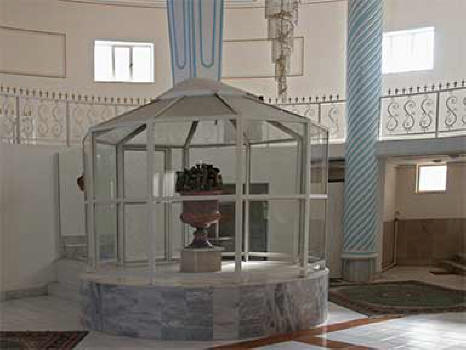 |
| New Fire Temple Inner Sanctum, Kerman |
|
Kerman Dakhma
 |
Dakhma 1: Old (disused) dakhma 2 km north of Kerman city limits on a hill called
Kuh-e Dakhmeh. Image credit: Kamali Amir at Panoramio |
|
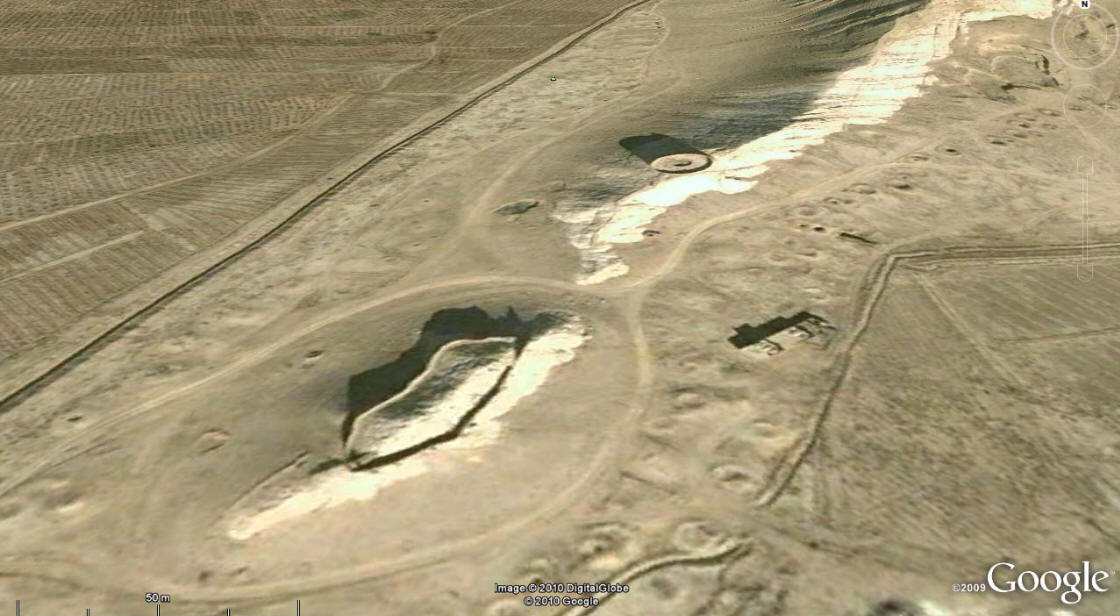 |
Aerial image of the Dakhma (circular structure) and adjacent walled structure (lower left).
The line of small circular impressions in the ground are probably the shaft tops of kareez (qanat) underground water canals. Image credit: Google Earth |
» Top
Suggested additional reading:
|



